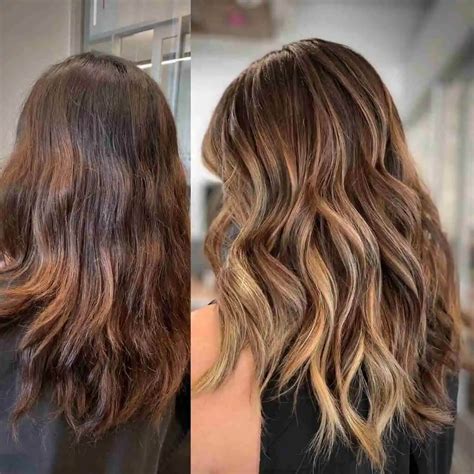Understanding the Differences
Balayage is a sophisticated hair coloring technique that creates natural-looking highlights. It involves painting the hair freehand, resulting in soft, blended transitions between shades. While balayage can be applied to the entire head (full balayage), it can also be executed in a more targeted manner (partial balayage).

Full Balayage
- Definition: Balayage applied to the entire head, from roots to ends.
-
Benefits:
- Evenly distributed highlights
- Creates a more dramatic and noticeable effect
-
Considerations:
- Higher cost
- Requires more maintenance (touch-ups)
Partial Balayage
- Definition: Balayage applied to specific sections of the hair, such as the top layer, sides, or ends.
-
Benefits:
- More subtle and natural-looking
- Lower cost
- Requires less maintenance
-
Considerations:
- Can appear less consistent
- May not provide the desired level of brightness
Choosing the Right Option for You
The choice between full and partial balayage depends on your personal preferences and hair goals.
Consider Full Balayage if:
- You desire a noticeable and transformative hair makeover.
- You have thicker hair that can handle regular touch-ups.
- You prefer a more dramatic and high-contrast look.
Consider Partial Balayage if:
- You favor a subtle and low-maintenance option.
- You have finer hair that may not tolerate frequent bleach treatments.
- You seek to enhance specific areas of your hair, such as framing your face or brightening your ends.
Comparative Table
| Feature | Full Balayage | Partial Balayage |
|---|---|---|
| Application Area | Entire head | Specific sections |
| Cost | Higher | Lower |
| Maintenance | Requires more touch-ups | Requires less touch-ups |
| Effect | More noticeable | More subtle |
| Hair Volume | Suitable for all hair volumes | Better for finer hair |
| Styling | Can enhance or diminish curls | May preserve curls |
Step-by-Step Balayage Process
Materials:
- Balayage brush
- Bleach
- Developer
- Toner
- Hair clips
- Gloves
Instructions:
- Section Hair: Divide the hair into manageable sections using clips.
- Apply Bleach: Paint bleach onto the desired sections using a balayage brush, focusing on the mid-lengths and ends.
- Develop: Allow the bleach to process according to the manufacturer’s instructions.
- Rinse and Tone: Rinse the bleach and apply toner to neutralize brassiness and achieve the desired shade.
- Condition: Condition the hair deeply to restore moisture.
Tips for Optimal Results
- Choose the Right Stylist: Opt for a professional colorist experienced in balayage techniques.
- Protect Your Hair: Use a heat protectant spray before blow-drying or styling.
- Use Purple Shampoo: Incorporate purple shampoo into your hair care routine to combat unwanted yellow tones.
- Moisturize Regularly: Condition or use hair masks to keep your hair hydrated and prevent breakage.
- Avoid Excessive Heat Styling: Limit the use of hot tools to preserve the integrity of your hair.
Frequently Asked Questions
- Is balayage damaging to hair? Yes, balayage involves bleach, which can cause damage to the hair. However, proper care and maintenance can mitigate the risks.
- How long does balayage last? Full balayage can last up to 6 months, while partial balayage may require touch-ups every 3-4 months.
- Can balayage be done on all hair colors? Yes, balayage can be adapted to most hair colors, including dark hair, but it may require multiple sessions to achieve the desired result.
- Is balayage suitable for short hair? Partial balayage can be a great option for short hair, adding subtle highlights and dimension.
- How much does balayage cost? The cost of balayage varies depending on factors such as the salon, stylist, and hair length.
- Can balayage be used to cover gray hair? Yes, balayage can be used to blend gray hairs and create a more natural-looking appearance.
